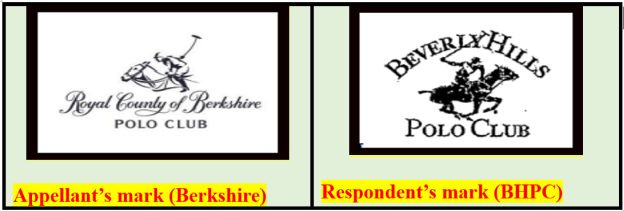Background
Lifestyle Equities, owner of the Beverly Hills Polo Club (BHPC) trademarks, had filed a commercial suit against Royal County of Berkshire Polo Club in the Delhi High Court in 2019, challenging the latter's use of a logo depicting a 'Horse and Polo Player' device on its product range.
The Hon'ble Single Judge vide judgement dated 6th May 2019, had held that Berkshire's Logo is deceptively and structurally similar to that of BHPC and as it relates to the same goods, i.e. fragrances it is likely to cause confusion among consumers. Berkshire had challenged this order in the appeal.

Source of the image: Division Bench Judgement
Appellate Court Overrules Decision of Single Judge Bench
The Appellate Court in the intra-court appeal observed that the Single Judge had erred in finding the competing marks similar solely on the basis of a part of the trademark (the image of a mallet-swinging polo player on a horse) that had become distinctive and recognisable by consumers. It was observed that the mark had to be seen as a whole as opposed to only one feature of the logo that may be similar or identical to one feature of the rival mark. The test is that the competing mark should bear a very close resemblance when seen as a whole. The Court has to be concerned with the overall presentation of the two marks.
Key Observations of the Division Bench:
Setting aside the impugned judgment the Appellate Court re-iterated the following legal principles that apply while comparing two marks:
- The question is to be approached from the point of view of a man of average intelligence and imperfect recollection for whom the overall structural and phonetic similarity of the two marks is likely to cause confusion.
- At the same time, it is permissible to determine a prominent/ essential feature of the mark and see whether the same is deceptively similar to the prominent/ essential feature of the competing mark.
Applying the above legal principle, the Appellate Court noted as follows:
- That the word "Polo Club" was identical but since the (BHPC) had admitted that they did not have any objection if the (Berkshire) were to use the words 'Polo Club', no dispute arose therein.
- Both logos use a picture depicting a polo player on horse back holding a mallet.
- It was also an admitted case that the logo of a horse and a player is being used by not only the parties in the present case but also by many other Polo Clubs and companies, one of the most prominent being international fashion brand 'Ralph Lauren', which is stated to be the earliest worldwide user of the logo of a polo device (1974).
- Berkshire Polo Club is not using the standalone polo player device as a mark but the same is accompanied by its name, that is, Royal County of Berkshire Polo Club.
- That the Appellant has been using the same/similar mark in its products in various other countries. Berkshire has got its Mark registered in more than 20 countries, and that various brands have been co-existing alongwith each other by using the polo player device in their product.
- Appellant cannot be faulted for using name in bona fide manner.
- When plaintiff has admitted that there is no likelihood of confusion and deception in the public with the use of words 'Polo Club' by both plaintiff and defendant, it cannot be presumed that with the addition of a logo which is different in their look with the words, 'Polo Club', would make the composite mark deceptively similar.
- The only similarity which is seen in the pictures of the competing marks is the photo of a horse and a polo player riding, which is associated with a polo club.
- The picture of the polo player device used by the Appellant is of a half horse whereas a full picture of a horse is depicted in the mark used by the Respondent.
- The club (mallet) held by the player in both the pictures is also shown to be in different directions.
- The dissimilarity in the pictures of the competing marks coupled with the fact that the same is used in conjunction with different words, are sufficient to distinguish the composite mark of the Respondent from that of the Appellant.
Author's take:
This case has put the spotlight on the concept of 'Deceptive Similarity' in the realm of intellectual property rights. The depth of factual analysis by the appellate Court while assessing the judgment raises some interesting and pertinent questions to ponder over by the legal fraternity:
First, while it noted the principles on which an Appellate Court can interfere, the question that arises is if this was the apt case for the Appellate Court to interfere when adjudication of an issue of deceptive similarity is—predominantly—based on facts.
Second, whether such a minute factual appreciation was necessary considering the principle of comparison of two similar marks should be from the point of view of a person of average intelligence and imperfect recollection. In other words, the in-depth analysis of the different directions of the horses in both marks and the half and full pictures of the respective horses was required at this appellate stage considering that the test applied is of a person of average intelligence with imperfect recollection.
Third, when applied in a real life scenario, how far can we expect the average customer in the Indian context to be able to engage in in-depth factual appreciation of two marks on products dealing in similar goods, if they were placed side to side.
To view original article click here
The content of this article is intended to provide a general guide to the subject matter. Specialist advice should be sought about your specific circumstances.


